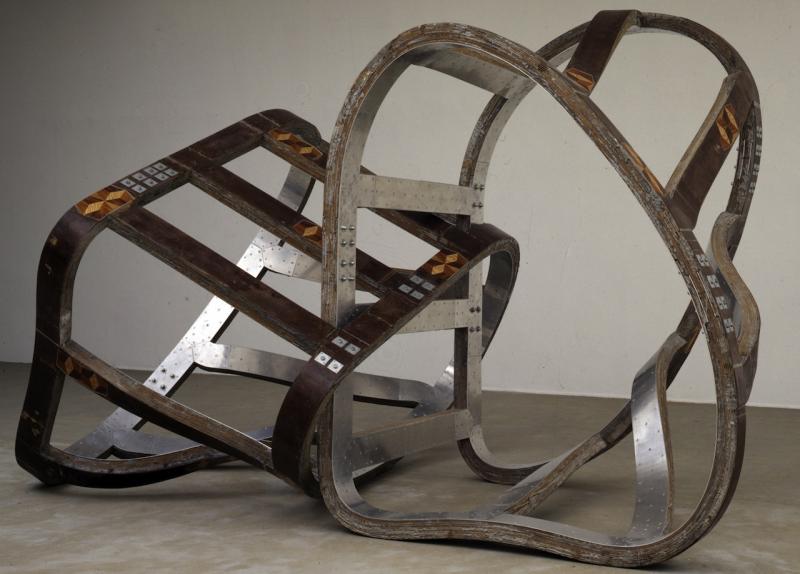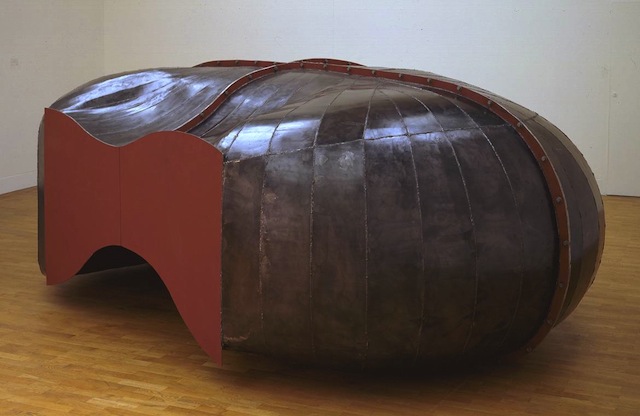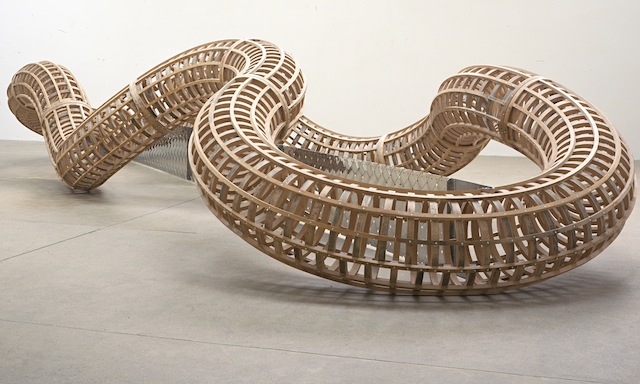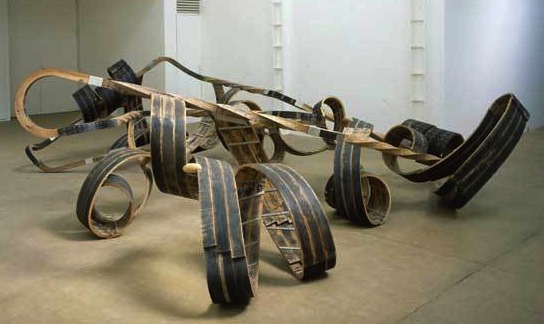Richard Deacon, Tate Britain | reviews, news & interviews
Richard Deacon, Tate Britain
Richard Deacon, Tate Britain
Extravagant forms and tensile structures in a powerful survey of the British sculptor

A retrospective is often a daunting prospect for all concerned, not least the poor visitor who must prepare for a gruelling marathon, visiting every forgotten cul-de-sac of an artist’s career.
With just 30 objects on display, it is certainly tempting to infer a brave curatorial strategy, emboldened by the reassuring presence of Deacon himself, who has been closely involved in the exhibition throughout. In reality, however, the show’s stripped back style must have been borne primarily out of necessity: Deacon’s sculptures are characterised by their grand scale and rambling, extravagant forms, which not only take up considerable floor space but demand a display area free from distractions. The curators have, nevertheless, been wise enough to make a virtue of this, adopting a pared back approach across the board, with the galleries kept as empty as possible, free from the usual clutter of barriers, labels and explanatory texts, allowing us to look at Deacon’s work unencumbered, with only the discreetly placed title of each work to inform our viewing.
The relationship between language and form has always been a preoccupation for Deacon
It is in these small but significant details that Deacon’s curatorial influence can surely be discerned; for him, the title is an essential part of the sculpture, setting up resonances and associations that merge and entwine with the object itself to inform and shape our understanding of it. The relationship between language and form has always been a preoccupation for Deacon, and beginning the exhibition with five drawings from the series It’s Orpheus When There’s Singing, 1978-9, provides a far better explanation of what follows than any text could possibly offer. Made using a pencil, a pin and a piece of string to draw arcs and circles from which a final form emerges, these drawings have a distinctly sculptural nature, Deacon describing the series as, “a process of trying to excavate a form from a developing set of lines”. The forms that emerge are often shell-like vessels, resembling ears, mouths and eyes, those body parts vital to generating meaning through language and experience, and which recur as motifs throughout Deacon’s career.
 The idea of an ear-like vessel occurs again in Struck Dumb, 1988 (pictured above), a mighty steel construction built at the Govan shipyards, its strange dark surface like a great industrial carapace, the red, wound-like panel on one side reinforcing the idea of a severed ear, or perhaps a mouth. Struck Dumb is an example of Deacon’s use of a title to great effect, the words nudging us towards a particular train of thought, and in this case setting up an almost overwhelming compulsion to discover what sort of noise this thing would make were we to strike it. But of course, no one is brave enough to find out, so we will never know: it is struck dumb. And there is another, more melancholy resonance here: this object has been made by an industry in terminal decline so that Deacon’s sculpture almost serves as a memorial to British shipbuilding, struck dumb.
The idea of an ear-like vessel occurs again in Struck Dumb, 1988 (pictured above), a mighty steel construction built at the Govan shipyards, its strange dark surface like a great industrial carapace, the red, wound-like panel on one side reinforcing the idea of a severed ear, or perhaps a mouth. Struck Dumb is an example of Deacon’s use of a title to great effect, the words nudging us towards a particular train of thought, and in this case setting up an almost overwhelming compulsion to discover what sort of noise this thing would make were we to strike it. But of course, no one is brave enough to find out, so we will never know: it is struck dumb. And there is another, more melancholy resonance here: this object has been made by an industry in terminal decline so that Deacon’s sculpture almost serves as a memorial to British shipbuilding, struck dumb.
 Setting up tension between object and viewer is something Deacon does brilliantly, nowhere more so than in the final rooms of this exhibition which contain two of his most stunning pieces of work, After, 1998 (pictured above) and Out of Order, 2003 (pictured below). Deacon has generally tended to emphasise the constructed nature of his sculptures, with lots of very obvious joins, rivets and screws flatly contradicting the sense of unity and completeness that often characterises his work. The vast structure of After uses the evidence of its construction to great effect; its flailing serpentine form is barely contained by a woven metal brace which restrains it with enormous bolts. The sculpture seems at breaking point, as if the bolts might suddenly fail, releasing this great monster of pent up energy writhing about the room.
Setting up tension between object and viewer is something Deacon does brilliantly, nowhere more so than in the final rooms of this exhibition which contain two of his most stunning pieces of work, After, 1998 (pictured above) and Out of Order, 2003 (pictured below). Deacon has generally tended to emphasise the constructed nature of his sculptures, with lots of very obvious joins, rivets and screws flatly contradicting the sense of unity and completeness that often characterises his work. The vast structure of After uses the evidence of its construction to great effect; its flailing serpentine form is barely contained by a woven metal brace which restrains it with enormous bolts. The sculpture seems at breaking point, as if the bolts might suddenly fail, releasing this great monster of pent up energy writhing about the room.
 A similar effect is achieved with Out of Order, its title suggesting the unnatural contortions the wooden components have been forced into, and filling us with a perverse anticipation of the sudden failure of a bolt or fastening, causing the whole thing to explode violently into life. Blackened in places by the steaming process used to shape pieces of oak into barley sugar twists and delicate curls reminiscent of wood shavings, the sculpture has the hulking, industrial feel of some of Deacon’s earlier work, and could almost be a piece of strange, complex machinery that has fallen into disrepair. Out of Order is capable of holding its viewers' attention indefinitely and for that extraordinary achievement must be worth the price of entrance alone.
A similar effect is achieved with Out of Order, its title suggesting the unnatural contortions the wooden components have been forced into, and filling us with a perverse anticipation of the sudden failure of a bolt or fastening, causing the whole thing to explode violently into life. Blackened in places by the steaming process used to shape pieces of oak into barley sugar twists and delicate curls reminiscent of wood shavings, the sculpture has the hulking, industrial feel of some of Deacon’s earlier work, and could almost be a piece of strange, complex machinery that has fallen into disrepair. Out of Order is capable of holding its viewers' attention indefinitely and for that extraordinary achievement must be worth the price of entrance alone.
Explore topics
Share this article
more Visual arts
 Fantastic Machine review – photography's story from one camera to 45 billion
Love it or hate it, the photographic image has ensnared us all
Fantastic Machine review – photography's story from one camera to 45 billion
Love it or hate it, the photographic image has ensnared us all
 Yinka Shonibare: Suspended States, Serpentine Gallery review - pure delight
Weighty subject matter treated with the lightest of touch
Yinka Shonibare: Suspended States, Serpentine Gallery review - pure delight
Weighty subject matter treated with the lightest of touch
 Jane Harris: Ellipse, Frac Nouvelle-Aquitaine MÉCA, Bordeaux review - ovals to the fore
Persistence and conviction in the works of the late English painter
Jane Harris: Ellipse, Frac Nouvelle-Aquitaine MÉCA, Bordeaux review - ovals to the fore
Persistence and conviction in the works of the late English painter
 Sargent and Fashion, Tate Britain review - portraiture as a performance
London’s elite posing dressed up to the nines
Sargent and Fashion, Tate Britain review - portraiture as a performance
London’s elite posing dressed up to the nines
 Zineb Sedira: Dreams Have No Titles, Whitechapel Gallery review - a disorientating mix of fact and fiction
An exhibition that begs the question 'What and where is home?'
Zineb Sedira: Dreams Have No Titles, Whitechapel Gallery review - a disorientating mix of fact and fiction
An exhibition that begs the question 'What and where is home?'
 Yoko Ono: Music of the Mind, Tate Modern review - a fitting celebration of the early years
Acknowledgement as a major avant garde artist comes at 90
Yoko Ono: Music of the Mind, Tate Modern review - a fitting celebration of the early years
Acknowledgement as a major avant garde artist comes at 90
 Unravel: The Power and Politics of Textiles in Art, Barbican review - the fabric of dissent
An ambitious exploration of a neglected medium
Unravel: The Power and Politics of Textiles in Art, Barbican review - the fabric of dissent
An ambitious exploration of a neglected medium
 When Forms Come Alive, Hayward Gallery review - how to reduce good art to family fun
Seriously good sculptures presented as little more than playthings or jokes
When Forms Come Alive, Hayward Gallery review - how to reduce good art to family fun
Seriously good sculptures presented as little more than playthings or jokes
 Entangled Pasts 1768-now, Royal Academy review - an institution exploring its racist past
After a long, slow journey from invisibility to agency, black people finally get a look in
Entangled Pasts 1768-now, Royal Academy review - an institution exploring its racist past
After a long, slow journey from invisibility to agency, black people finally get a look in
 Barbara Kruger, Serpentine Gallery review - clever, funny and chilling installations
Exploring the lies, deceptions and hyperbole used to cajole, bully and manipulate us
Barbara Kruger, Serpentine Gallery review - clever, funny and chilling installations
Exploring the lies, deceptions and hyperbole used to cajole, bully and manipulate us
 Richard Dorment: Warhol After Warhol review - beyond criticism
A venerable art critic reflects on the darkest hearts of our aesthetic market
Richard Dorment: Warhol After Warhol review - beyond criticism
A venerable art critic reflects on the darkest hearts of our aesthetic market
 Dineo Seshee Raisibe Bopape: (ka) pheko ye / the dream to come, Kiasma, Helsinki review - psychic archaeology
The South African artist evokes the Finnish landscape in a multisensory installation
Dineo Seshee Raisibe Bopape: (ka) pheko ye / the dream to come, Kiasma, Helsinki review - psychic archaeology
The South African artist evokes the Finnish landscape in a multisensory installation

Add comment